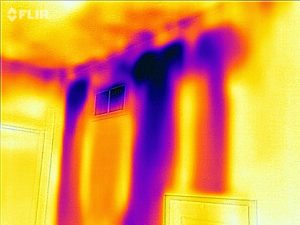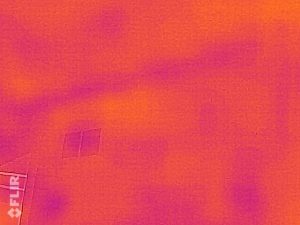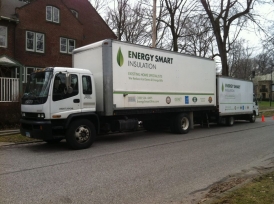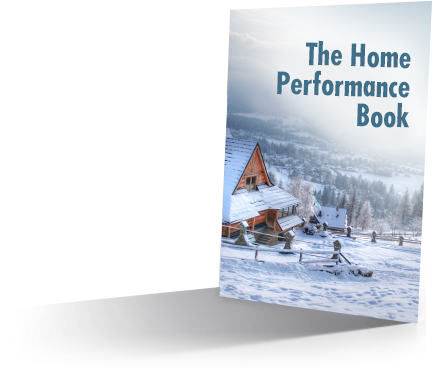The knight in shining armor is a caulk or foam gun.
The Root of All Evil?
OK, that’s a bit melodramatic, the love of money is the root of all kinds of evil. However, we find that in client homes, air leakage is the root of all kinds of evil.
Here are a few problems that usually are caused by too much air leakage: ice dams and icicles, hot or cold rooms, overheated second floors in summer, mold, indoor asthma and allergies, and more. We have what we call The Five Priorities of Home Performance, they are the typical order that projects need to be done in. The first three are all air sealing. I can’t overstate the importance of air sealing for solving problems in your home. In our process we test for it with a blower door in the very first visit to your home, the Initial Consultation.
Why Do I Need to Air Seal?
1. The Leaky Boat Principle
A leaky house is nearly impossible to control. It’s like a boat with a leak that always has a foot of water in it. The solution is not to put in a bigger engine or bilge pump (the furnace or air conditioner in your home), it’s to seal the leaks. Once you have control of water leaking into a boat, you have a good boat. Same thing with air leaking into your home.
2. The Stack Effect
This is the main reason to air seal your home. A house works a lot like a smoke stack. Hot air rises through the house until it exits in the attic. If you seal off a smoke stack at the top, the bottom, or both, you don’t have a smoke stack. In air sealing a house we are trying to stop the stack effect as much as we can.
In the summer, stack effect reverses. Heat from the attic pushes into your home. If the second floor of your home is hotter than the first in the summer, this is a big part of why. There should be no more than a 2-3 degree difference between floors. Here’s what summer stack effect, or reverse stack effect, looks like:
The stack effect isn’t easy to see on a day to day basis, but with a tool called a blower door that sucks on your house and pulls outside air into your home through leaks, you can find out where the leaks are. Here is a great example of where the top of a wall was extremely leaky.
The second floor of this home was very uncomfortable, and leaky walls were the main cause. Comfort levels in this room were a 3 out of 10, according to the client, with 1 being miserable. Comfort levels are now a 9/10. See the 1970s Two Story case study to see how we fixed it. Here’s how that same spot looked later:
We largely stopped the stack effect in this home. What needs to be fixed in yours?
3. The Wind Breaker on a Pier Principle
Think about standing on a pier in a stiff winter wind wearing nothing but a t-shirt and jeans. You’re teeth are chattering from the cold. I cruelly give you the option of either a wind breaker or a loose knit sweater. Which one do you want? The wind breaker, of course. It at least stops the wind, where wind blows right through a sweater. Ideally you want both, a wind breaker (air sealing) over a sweater (insulation). That is what you want with your home, wrapping an air seal around your insulation.
The Top 10 Things to Know About Air Sealing
- Your house likely leaks 1.5 to 3 times as much as it should. This means you are paying to heat and cool air that escapes outside to quickly.
- A drafty home has a lot of air leaks.
- Air leakage into the attic is a primary cause of ice dams. Even if you have a lot of insulation, leaking air carries more than enough heat to melt snow on the roof.
- Air leakage is measured with a blower door. A blower door is a special fan that fits in one of your doors and pulls a little air out of your house in order to measure how much it leaks and where from.
- Air leakage is measured in CFM50, or cubic feet per minute at 50 Pascals. A Pascal is a very small unit of pressure, jokingly referred to as ‘mouse farts’ in the industry. 50 Pascals is the equivalent of a 20 mph wind blowing at all sides of your house at the same time.
- Your house can be too tight, but most older houses aren’t easily capable of it.
- If your house does get too tight, it can be fixed! Bathroom fans, ERVs, HRVs, and several other methods can be employed for Fresh Air Ventilation also known as Mechanical Ventilation.
- The optimal leakage rate for a house is 0.35 air changes per hour (ACH) according to BPI standards. This means that your house will naturally change its air once every 3 hours. Very leaky houses may change their air every 30-60 minutes, making your home uncomfortable because it is hard to control.
- BPI, or the Building Performance Institute, is the most accepted standard maker for existing homes. RESNET focuses on new homes.
- Many air sealing tasks are easily undertaken by homeowners. The basement is prime territory for DIYers. Sealing up outlets and light switches is also very simple. Attics are not quite as easy because leaks are harder to find. Insulating walls is best left to the professionals because rental equipment is not powerful enough to do the job.
What Is Air Sealing?
Air sealing is the systematic finding and sealing of air leakage points throughout your home, from the attic to the walls to the basement and/or crawlspace. It’s very unsexy work, usually in the not so nice parts of your home like attics and crawlspaces. Here is a brief breakdown of the process for the various parts of your home.
1. Attic Air Sealing
Lights, Fans, Plumbing Stacks, Chimneys, etc. – Any hole in your ceiling is called a thermal bypass, or air leak. We spray foam around most of these, including around light fixtures, bathroom fans, open wall cavities, and plumbing stacks. Other items like chimneys and recessed lights require special methods. There are a large number of items that require a professional to find and correct properly.
2. Wall Air Sealing
Insulation and/or Outlet Sealing – The simplest item on walls is to put foam backers behind the outlet covers and child proof plugs to stop air coming out the outlet holes. The harder part is insulating walls. If you have a newish home, about 1970 or later, your walls are probably insulated. If you have an older home, especially before 1965, your walls are probably empty. Empty walls generally account for 20-40% of air leakage, and are the best area to reduce leakage. We can insulate most walls and drastically reduce both the air leakage and energy bills of your older home.
3. Basement/Crawlspace Air Sealing
There is a lot of leakage in the basement, and since it is accessible in most homes, it is a priority for any home performance contractor. Here are the big areas we focus on. These all make good DIY projects too!
a. Band/Rim Joist
This is the vertical board on top of the masonry foundation that runs like a band around your house. The top of it sits just below the floor of your first floor and is a major leakage point. The bottom of the band joist sits on top of the sill plate, and is another major leakage point. Also, any holes through the band joist like the electrical service, dryer vent, hose spigot, air conditioner line, etc. also need to be sealed. Caulk and foam are our usual weapons.
b. Sill Plate/Sill Sealer
The sill plate is the horizontal board that sits directly on top of your foundation. Between the sill plate and foundation is the sill sealer, which ironically rarely seals the sill. It can be either a layer of mortar in older homes, a 1/2” thick black felt-like band in 1960s-1980s homes, or a thin layer of foam. This is best sealed up with foam.
c. Holes in the Floor
Any holes through the basement ceiling, such as electrical and plumbing lines, chimneys, or duct work. Any of these items, particularly plumbing lines and the chimney, can be connected through walls from the basement to the attic, creating a mini smokestack. Since there is no way to know for sure which ones connect and which don’t, it’s best to seal them all.
d. Leaky Ducts
Duct work typically leaks 10-30% meaning that a lot of the air you are paying to heat or cool is leaking somewhere it shouldn’t. If the ducts are in the walls, there isn’t much you can do short of ripping walls apart (don’t bother, drywall costs a lot more than the energy you’ll save). Any ductwork in the basement can be sealed though. Ironically, don’t use duct tape, it will fail within a few years. On any seams or cracks, either cover them with foil tape or mastic. Mastic is a tile glue that can be found in either the duct work or tile sections at your local building supply store.
Related Content
The Three Most Important Things to Make Your Home Comfortable and Efficient
What Does a Blower Door Number Mean?
















